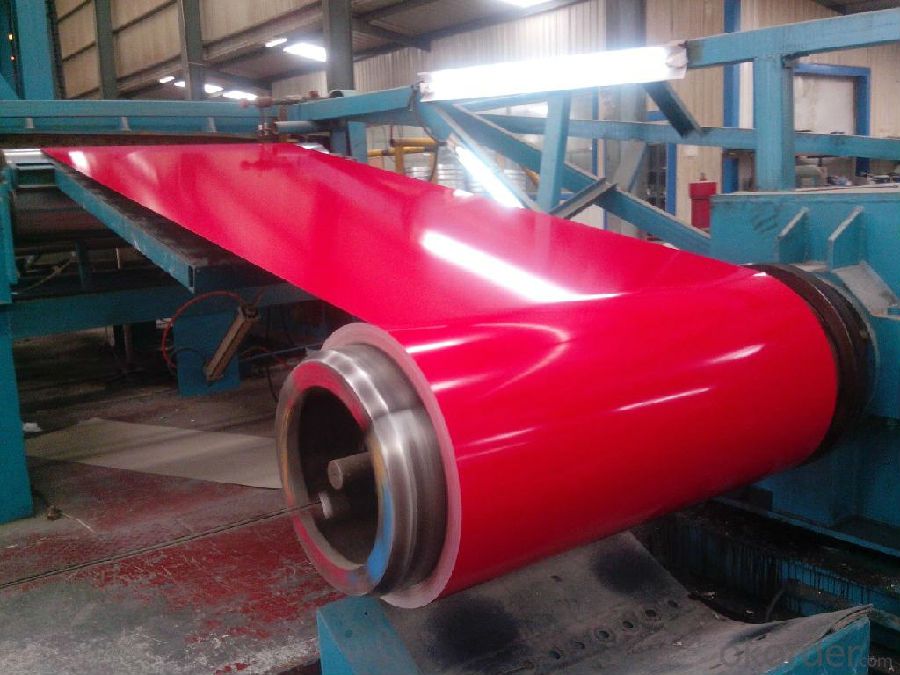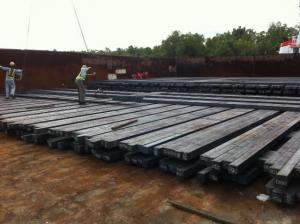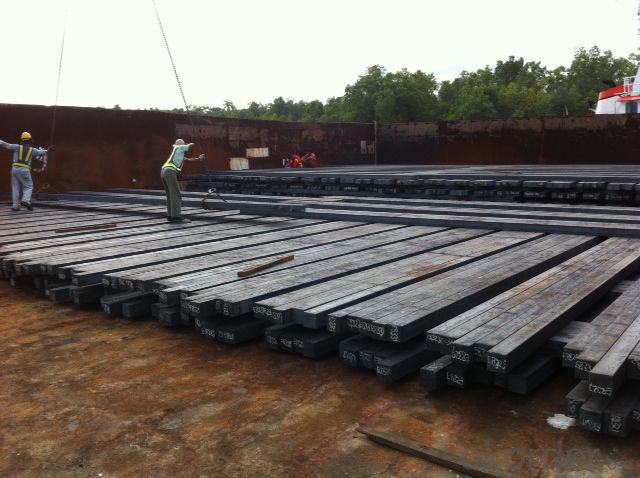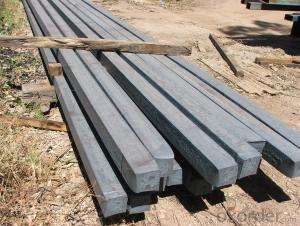Hot Rolled Steel Billet 3SP Standard 185mm
- Loading Port:
- Shanghai
- Payment Terms:
- TT OR LC
- Min Order Qty:
- 100 m.t.
- Supply Capability:
- 10000 m.t./month
OKorder Service Pledge
OKorder Financial Service
You Might Also Like
Structure of Hot Rolled Steel Billet 3SP Standard 185mm

Description of Hot Rolled Steel Billet 3SP Standard 185mm
Prepainted Rolled steel Coil is a kind of coated steel coil/sheet. With the cold rolled steel of different strength and thickness as substrate, it is produced through applying Al-Zn coat on both faces by hot dip process. In its coating, Al accounts for about 55%, Si 1.6%, while the remaining is Zn. Aluminum zinc coils enjoys both the physical protective feature and durability of Al and the electrochemical protective property of Zn. And its surface has bright silver color and regular embossed-like figure, which are highly decorative. RAL Scale Z35 Prepainted Rolled Steel Coil for Construction Roofing

Main Feature of Hot Rolled Steel Billet 3SP Standard 185mm
1.Corrosion resistance: It mainly depends on the zinc protection. When the zinc being worn,
2. Heat resistance: steel sheet has excellent heat resistance, can withstand high temperatures over 300 centigrade, and is similar with aluminized steel high temperature oxidation resistance. It often used in chimney pipes, ovens, fluorescent lighting device and the device cover.
3. Heat reflective: Galvanized steel plate heat-reflective high rate is twice as galvanized steel, often used to make insulation materials. RAL Scale Z35 Prepainted Rolled Steel Coil for Construction Roofing
Applications of Hot Rolled Steel Billet 3SP Standard 185mm
1. Construction and building: roofing; ventilating duct; handrail; partition panel;etc.
2. Electric appliance: refrigerator; washing machine; refrigerator; DVD;etc.
3.Transportation: oil tank; gas tank;road sign; etc.
4.Agriculture constructions :barn; etc.RAL Scale Z35 Prepainted Rolled Steel Coil for Construction Roofing
5.Others:vending machine; game machine; auto parts spare parts etc.

Specifications of Hot Rolled Steel Billet 3SP Standard 185mm
Product | Hot Rolled Steel Billet 3SP Standard 185mm |
Material Grade | SGCC / SGCH / DX51D+AZ, etc |
Thickness | 0.5-3.0mm |
Width | 700-1500mm |
Tolerance | Thickness: +/-0.02mm , Width:+/-2mm |
Zinc-coating | AZ30-150g/m2 |
Technique | Raw material: Hot rolled steel coil --> Cold rolled_>hot dipped galvalume |
Surface | Dried, Chromated, Unoiled,RAL Scale Z35 Prepainted Rolled Steel Coil for Construction Roofing |
Spangle | Regular spangle , small spangle, zero spangle |
ID | 508MM 610MM |
Coil weight | 25MT max |
Export package | Cardboard inner sleeves, Waterproof paper, galvanized steel covered and steel strip packed |
FAQ of Hot Rolled Steel Billet 3SP Standard 185mm
We have organized several common questions for our clients,may help you sincerely:
1. What is the minimum order quantity ?
Our MOQ is 100 mt for each size each specification. Usually we can offer discount if can buy large QTY once. RAL Scale Z35 Prepainted Rolled Steel Coil for Construction Roofing
2. How long can we receive the product after ordering?
Our general delivery time is 30 days after confirmation, but so some special orders, we have offer special delivery time
3. How to guarantee the quality of the products?
We have established the international advanced quality management system ,every link from raw material to final product we have strict quality test;We resolutely put an end to unqualified products flowing into the market. At the same time, we will provide necessary follow-up service assurance.
4. What is the payment?
We accept T/T, L/C
- Q: What are the different quality standards for steel billets?
- Steel billets undergo assessment based on various quality standards to determine their overall quality and suitability for different purposes. Notable quality standards include: 1. ASTM A615/A615M: This standard outlines the criteria for deformed and plain carbon-steel bars used in concrete reinforcement. It encompasses billets utilized in the production of reinforcing bars, focusing on their specific mechanical properties and dimensional tolerances. 2. ASTM A706/A706M: This standard specifies the requirements for low-alloy steel utilized in the production of reinforcing bars. It details the chemical composition, mechanical properties, and dimensional tolerances of the billets. 3. EN 10025-2: A European standard that stipulates the requirements for non-alloy structural steels. It covers billets used in the production of various structural elements, including beams, columns, and plates. The standard defines the chemical composition, mechanical properties, and technical delivery conditions of the steel billets. 4. JIS G3112: A Japanese industrial standard that addresses steel bars employed in concrete reinforcement. It outlines the chemical composition, mechanical properties, and tolerances for billets used in the production of reinforcing bars. 5. GB/T 699: A Chinese standard that establishes the quality requirements for carbon structural steels. It defines the chemical composition, mechanical properties, and technical delivery conditions of steel billets used in diverse structural applications. These quality standards guarantee that steel billets meet specific criteria concerning strength, durability, and dimensional accuracy. By adhering to these standards, one ensures that the steel billets are of superior quality and suitable for their intended use in construction, manufacturing, and reinforcement applications.
- Q: How do steel billets contribute to the manufacturing of marine gear?
- Steel billets contribute to the manufacturing of marine gear by serving as the raw material for the production of various components, such as gears, shafts, and bearings. These billets are first heated and then shaped through forging or machining processes to create the desired gear components with high strength and durability. The use of steel billets ensures that the marine gear can withstand the harsh conditions of marine environments, such as corrosion, high loads, and extreme temperatures, ultimately enhancing the performance and reliability of the gear in marine applications.
- Q: How do steel billets contribute to the manufacturing of tools and equipment?
- Tools and equipment manufacturing relies heavily on steel billets, which serve as a crucial component. These semi-finished steel products play a vital role in shaping and forming the final products used across different industries. To begin with, steel billets function as raw materials during the production of various tools and equipment. They act as the starting point for processes like forging, rolling, and extrusion. These processes involve heating and shaping the steel billets to achieve the desired form and dimensions of the tools and equipment. Furthermore, steel billets possess several advantages that make them suitable for tool and equipment manufacturing. The strength and durability of steel make it an ideal material for tools that need to endure heavy loads and harsh conditions. Additionally, the versatility of steel allows for the production of a wide range of tools and equipment, including cutting tools, machine parts, construction equipment, and automotive components. Moreover, steel billets can be easily machined and formed into complex shapes, enabling the production of intricate tools and equipment that meet specific requirements. The excellent machinability of steel allows for precise cutting, drilling, and milling processes, resulting in accurate dimensions and smooth surfaces. Additionally, steel billets can undergo heat treatment to enhance their mechanical properties, such as hardness and toughness. Processes like quenching and tempering can significantly improve the performance and longevity of tools and equipment. When combined with the inherent strength of steel, these processes ensure that the final products have the necessary strength, hardness, and wear resistance to effectively fulfill their intended functions. In conclusion, steel billets are indispensable in the manufacturing of tools and equipment due to their raw material capabilities and advantageous properties. They provide a reliable and versatile starting point for producing various tools and equipment, enabling the creation of durable, precise, and high-performance products that are vital to numerous industries.
- Q: How do steel billets contribute to the manufacturing of kitchen appliances?
- Kitchen appliances rely on steel billets as an essential component for their production. These semi-finished steel products, typically rectangular or square in shape, are created through continuous casting. One way in which steel billets contribute to the manufacturing of kitchen appliances is by serving as the primary raw material for various appliance components. Stoves, ovens, refrigerators, and dishwashers require a strong and durable structure, which steel billets provide. Through processes like hot rolling, forging, or extrusion, the billets are transformed into specific parts such as frames, doors, panels, and handles. Steel billets also play a vital role in ensuring the longevity and reliability of kitchen appliances. With its high tensile strength and resistance to corrosion, steel allows manufacturers to create appliances that can withstand daily use and endure for a long time. By using steel billets as the base material, kitchen appliances can handle high temperatures, heavy loads, and harsh environments without compromising their structural integrity. Moreover, steel billets contribute to the aesthetic appeal of kitchen appliances. The smooth and polished surface of steel provides an attractive and modern finish, making appliances visually appealing to consumers. Steel can also be easily manipulated to achieve different shapes and designs, allowing manufacturers to create sleek and stylish appliances that complement the overall kitchen decor. Additionally, steel billets possess excellent heat conductivity properties, which is crucial for kitchen appliances like stoves and ovens. The even distribution of heat throughout the appliance ensures efficient cooking and baking, guaranteeing that food is cooked thoroughly and evenly. In conclusion, steel billets are indispensable in the manufacturing of kitchen appliances due to their strength, durability, aesthetics, and heat conductivity properties. Without these billets, it would be challenging to produce high-quality, reliable, and visually appealing kitchen appliances that meet consumer demands.
- Q: What are the different methods of surface treatment for steel billets?
- Some of the different methods of surface treatment for steel billets include shot blasting, pickling, galvanizing, painting, and powder coating.
- Q: How are steel billets forged into shape?
- Steel billets are forged into shape through a process known as hot forging. Hot forging involves heating the steel billet to a temperature that allows it to be manipulated easily, usually between 1100 to 1250 degrees Celsius. Once the billet is heated, it is placed on a die, which is a specially designed tool with a cavity that gives the desired shape to the final product. A large mechanical or hydraulic press exerts pressure on the billet, forcing it into the die cavity. This pressure causes the steel to flow and fill the shape of the die, resulting in the desired form of the forged product. The pressure applied during forging can be as high as several thousand tons, depending on the size and complexity of the product. During the forging process, the steel billet undergoes plastic deformation, which rearranges its internal structure and aligns the grains of the metal. This alignment of grains enhances the mechanical properties of the forged product, making it stronger and more durable. After the initial shaping, additional operations such as trimming, piercing, or punching may be performed to achieve the final dimensions and features. These post-forging operations may be done while the steel is still hot or after it has cooled down. Once the desired shape is achieved, the forged product is cooled slowly to relieve any residual stresses and prevent cracking. This cooling process, known as annealing, helps improve the metallurgical properties of the steel and enhances its overall performance. In summary, steel billets are forged into shape through a hot forging process that involves heating the billet, placing it on a die, applying high pressure to force it into the desired shape, and then cooling it down to optimize its mechanical properties. This process allows steel to be transformed into various complex shapes, making it a versatile and widely used material in many industries.
- Q: What is the role of steel billets in the production of railway wagons?
- Steel billets play a crucial role in the production of railway wagons, serving as the primary raw material for manufacturing various wagon components. Essentially, steel billets are semi-finished steel products that are cast into specific shapes, typically squares or rectangles, and serve as the starting point for further processing. In the production process, steel billets are first heated to a high temperature and then passed through rolling mills to shape them into desired forms such as beams, plates, angles, channels, or other structural components. These components form the structural framework of the wagons, providing strength, durability, and stability. The exceptional strength and ability of steel billets to withstand heavy loads make them ideal for railway applications. They possess excellent mechanical properties, including high tensile strength, ensuring the wagons can endure the stresses and strains experienced during operation. The use of steel billets also allows for flexibility in design and customization, as they can be easily shaped and formed according to specific requirements. Manufacturers can produce railway wagons of various sizes, configurations, and capacities to cater to different transportation needs. Furthermore, steel billets are highly resistant to corrosion, which is particularly important for railway wagons exposed to harsh environmental conditions. This resistance helps maintain the structural integrity of the wagons, preventing premature deterioration and ensuring their long service life. Overall, steel billets are indispensable in the production of railway wagons. They provide the necessary strength, durability, and customization options required for manufacturing robust and reliable wagons that can withstand the demanding conditions of railway transportation.
- Q: How are steel billets used in the manufacturing of wire products?
- Wire products rely on steel billets as a crucial element in their production. These billets serve as the initial material for the wire manufacturing process. Typically, steel billets are semi-finished items that take the form of rectangular or square shapes. Molten steel is solidified to create these billets, which then undergo various shaping techniques to achieve the desired dimensions. The first step in using steel billets for wire production involves heating them to a specific temperature in a furnace. This procedure, known as annealing, serves to soften the steel and increase its malleability. Consequently, it becomes easier to mold the billets into wire shapes. Once the billets have been heated and softened, they are subjected to a series of rollers and drawing dies. These machines gradually decrease the cross-sectional area of the billets, elongating them into the desired wire diameter. Wire drawing is the term used to describe the process of reducing the billets' diameter. Throughout the wire drawing process, the steel billets undergo multiple passes through the rollers and drawing dies. Each pass further reduces the diameter of the billets until they reach the desired wire size. This continuous reduction in diameter also enhances the mechanical properties of the wire, such as tensile strength and ductility. Following the wire drawing process, the steel wire is typically wound onto spools or reels for additional processing or distribution. Depending on its intended use, the wire may undergo further treatments, such as heat treatment or surface coating, to enhance its properties or provide protection against corrosion. In conclusion, steel billets are utilized in wire product manufacturing through a series of steps involving heating, shaping, and drawing through rollers and dies to reduce their diameter and transform them into wire shapes. This process enables the production of wires with varying dimensions and properties, making them suitable for a wide array of applications in industries such as construction, automotive, electrical, and manufacturing.
- Q: What are the different grades of steel billets?
- There are several different grades of steel billets, including low carbon steel, medium carbon steel, high carbon steel, alloy steel, and stainless steel. The specific grade of steel billet used depends on the intended application and desired properties of the final product.
- Q: What is the role of steel billets in the manufacturing of automotive body panels?
- Steel billets play a crucial role in the manufacturing of automotive body panels. These billets, which are essentially semi-finished metal products, serve as the starting material for the production of various components that make up the body of a car. The primary reason steel billets are used in this process is because of their excellent strength and durability. Automotive body panels need to withstand various external forces and impacts, such as collisions, extreme weather conditions, and everyday wear and tear. Steel, being a strong and rigid material, provides the necessary structural integrity to ensure the safety and longevity of the vehicle. Furthermore, steel billets offer versatility in terms of design and customization. They can be easily molded and formed into different shapes and sizes, allowing manufacturers to create body panels with precise specifications. This flexibility enables the production of various car models with distinct designs, meeting the diverse demands of consumers. Steel billets are also preferred for their cost-effectiveness. Steel is a widely available and relatively inexpensive material, making it a practical choice for mass production. Moreover, its recyclability further reduces production costs and minimizes environmental impact. In summary, the role of steel billets in the manufacturing of automotive body panels is crucial. They provide the required strength, durability, versatility, and cost-effectiveness necessary for the production of high-quality and reliable car bodies.
Send your message to us
Hot Rolled Steel Billet 3SP Standard 185mm
- Loading Port:
- Shanghai
- Payment Terms:
- TT OR LC
- Min Order Qty:
- 100 m.t.
- Supply Capability:
- 10000 m.t./month
OKorder Service Pledge
OKorder Financial Service
Similar products
Hot products
Hot Searches
Related keywords
































